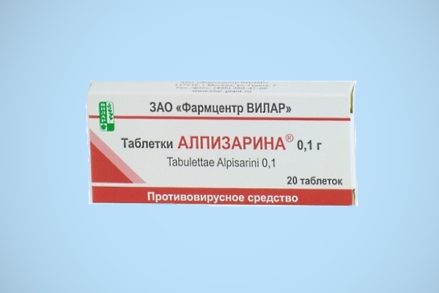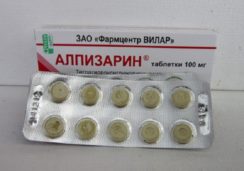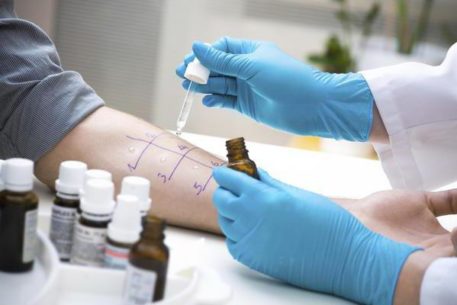Alpizarin is an active low-toxic antiviral medication of plant origin, which has the additional ability to suppress the vital activity of bacteria, fungi, inhibit their growth, relieve the inflammatory process and strengthen local and general immune defense forces. The medicine is produced from mangiferin glycoside, which is obtained by extracting the leaves and bark of the mango tree or from the grass of alpine penny.
Material Content:
Composition and release forms
Alpizarin is produced in two dosage forms, the main therapeutic component of which is tetrahydroxyglucopyranosylxanthene:
- Round flat pale yellow dividing tablets containing 100 mg (0.1 g) of tetrahydroxyglucopyranosylxanthene. One or two PVC-aluminum blisters with 10, 20 or 30 tablets are placed in a pharmaceutical package, applying medical instructions.
- Ointment (2 and 5%) for local application of a pale yellow color, containing 1 or 2 mg of the therapeutic ingredient in 1 gram, in tubes of 5, 10 and 20 g.
Additional components:
- in tablets - starch, milk sugar, calcium stearic acid;
- in ointment - purified vaseline.
What is Alpizarin prescribed for?

How does the medication
Alpizarin prevents the penetration of the microorganism into the tissue cell, inhibiting the growth and aggression of the herpes zoster and red lichen virus, E. coli, herpes simplex and genital herpes virus, Staphylococcus aureus, microsporia fungi, cytomegalovirus, tuberculous mycobacteria, vaginal trichomonas and dysenteric.
Recent laboratory and clinical studies have revealed the property of tetrahydroxyglucopyranosylxanthene to suppress HIV.
The medicine stimulates local and general immunity, is capable of activating the production of gamma-interferon protein by the cells of the immune system, which resists the aggression of infectious organisms, and relieves inflammatory edema.
Mangiferin is considered one of the substances with pronounced antioxidant activity, which perfectly protects the epidermis from harmful environmental factors and solar radiation.
After internal administration, the active substance is rapidly absorbed, reaching a maximum plasma concentration in 1 to 3 hours. Penetrates into all tissues and organs, including the brain. It is removed from the body with urine and partially with feces.
Indications for use
Alpizarin is used to treat patients of different ages, including children from 3 years old, as an independent tool or in combination with other medications in the treatment of sluggish and acute pathologies:
- anogenital and out-of-genital herpetic infection affecting both the body and the mucous membranes of the external genitalia and anus;
- gingivitis, pharyngotonzillitis caused by herpes virus;
- herpetic eczema (Kaposi syndrome);
- chicken pox;
- herpetic vesicular dermatitis;
- aphthous herpes virus stomatitis (inflammation of the oral mucosa with the formation of ulcers);
- herpes zoster, simple vesicle and lichen planus;
- viral flat warts, molluscum contagiosum;
- cytomegalovirus infection.
Studies have confirmed that with bullous otitis caused by the herpes virus, with Alpizarin treatment, recovery occurred 2 to 3 days earlier, and therapy with the initial phase of the formation of the blister prevented further bull growth.
With ARVI, if the patient received a medication in the first 2 days, the development of the disease was completely suppressed.
Instructions for use and dosage
general information
The maximum antiviral and antimicrobial effectiveness when using any form of Alpizarin is noted at an early stage of the disease.
The duration of the course is determined by the type of disease and the severity of pathological manifestations.
The complex appointment of tablets and ointments Alpizarin shows a more pronounced therapeutic result.
According to the observations of doctors for 4 - 5 days of using the medication:
- the severity of inflammatory phenomena, the intensity of vesicle rashes decreases;
- blanching of hyperemic areas of the skin, rapid healing of ulcers and bursting vesicles are noted.
In addition, comprehensive treatment:
- helps to lengthen the remission of pathologies, reduce the frequency of relapses;
- prevents the attachment of an abscess infection;
- enhances local immune defense and the body's overall resistance to viral infection.
Alpizarin tablets
Treatment with Alpizarin tablets is not associated with food intake.
Estimated doses:
- 2 to 3 doses of 50 to 100 mg of tetrahydroxyglucopyranosylxanthene are sufficient for preschoolers 3-6 years old;
- children 7-12 years old will need 2 to 3 times a pill;
- for patients over 12 years of age, the recommended treatment regimen provides for 3 to 4 times the use of 100 to 200 mg of the drug for 6 to 12 days.
The greatest amount of medical equipment received per day by kids and adolescents cannot exceed 3 tablets, by adults (from 12 years old) - 8 tablets.
With ulcerative stomatitis, extensive rashes on the body, face and genitals, fever, chills, enlargement or inflammation of the lymph nodes, Alpizarin should be taken for at least 7-14 days.
When diagnosing a cytomegalovirus infection, herpetic eczema, the duration of therapy may increase to 20 or more days.
With the development of signs of chickenpox, shingles, the medicine is prescribed for a period of 4 to 5 days to 3 weeks, which is determined by the degree of skin manifestations.
If the disease worsens, a second course of medication is required. After 3 to 4 weeks after completion of therapy, in order to prevent a recurrence of herpetic infection, the doctor may prescribe prophylactic administration of Alpizarin for 10 to 12 days.
Alpizarin ointment
Alpizarin ointment is an independent drug or adjuvant, if used in combination with Alpizarin tablets in severe forms of viral infection. The tool helps relieve itching, swelling of the tissues, reduce the severity of skin manifestations.
An ointment with a concentration of a therapeutic substance of 5% is used only for external skin treatment in adults. Ointment 2% treat the skin of children (up to 12 years) and the mucous membranes of the mouth, nose and genitals in patients of all age groups.
The duration of ointment applications also depends on the type of pathology and the severity of the symptoms. The average duration of the course is 7 to 20 days.
When applied externally, the product has virtually no effect on internal organs.
The medication is applied in a thin layer 3-6 times a day, rubbing lightly, without pressure. The dressing is not applied, but with severely expressed and limited in area rashes, the imposition of an untight bandage is allowed.
Treatment options, including combination regimens
- In case of acute herpesvirus infection of the skin outside the genital organs, the area with a rash is lubricated for 4 to 5 days 2 to 3 times a day. By the end of the second day, puffiness and redness around the vesicles usually decrease, crust formation is observed on the 3rd day of therapy, and healing usually occurs on the 5-7th day.
- If massive rashes appear or a skin rash is accompanied by swelling of the lymph nodes, temperature, Alpizarin ointment is combined with the use of a medication inside for 1 to 2 weeks.
- With the manifestation of a herpetic rash around the anus, on the genitals, pathological foci daily for 7-12 days are treated 4-6 times with 2% ointment. If the disease occurs repeatedly, treatment must be supplemented with prescription pills.
- With chickenpox and lichen, it is required to combine the local treatment of rashes with ointment of the desired concentration for 7 to 20 days with the parallel use of tablets (in age doses).
- With lesions of the mucous membrane of the oropharynx with the formation of ulcers (aphthous stomatitis, herpetic tonsillitis), gums (herpetic gingivitis), 2% lubricate pathological foci in the mouth, and take the medication orally for 1 to 2 weeks. Erosive-ulcerative red lichen in the oral cavity requires a longer combination treatment for up to 4 weeks.
- With herpes virus eczema, damage to the body by cytomegalovirus, ointment applications are necessarily combined with taking tablets, especially if the disease is accompanied by temperature, swollen lymph nodes, and weakness. Eczematous foci and vesicles are lubricated every day 5 to 6 times for 14 to 21 days.
During pregnancy and lactation
Studies on the effect of tetrahydroxyglucopyranosylxanthene on the fetus and the course of pregnancy have not been conducted. The effect of the active substance that passes into breast milk is also unknown. In this regard, the use of a medication in tablets in nursing and pregnant women is allowed only with a threat to the life of the mother.

Since the therapeutic substance, when applied to the skin and mucous membranes, hardly penetrates the blood and does not have a general effect on the body, Alpizarin ointment can be used in lactating women and during pregnancy after 12 weeks. But only in short courses, after consultation with a gynecologist and pediatrician. In no case is it possible to apply ointment to the mammary glands if the patient feeds the baby with breast milk.
Drug interaction
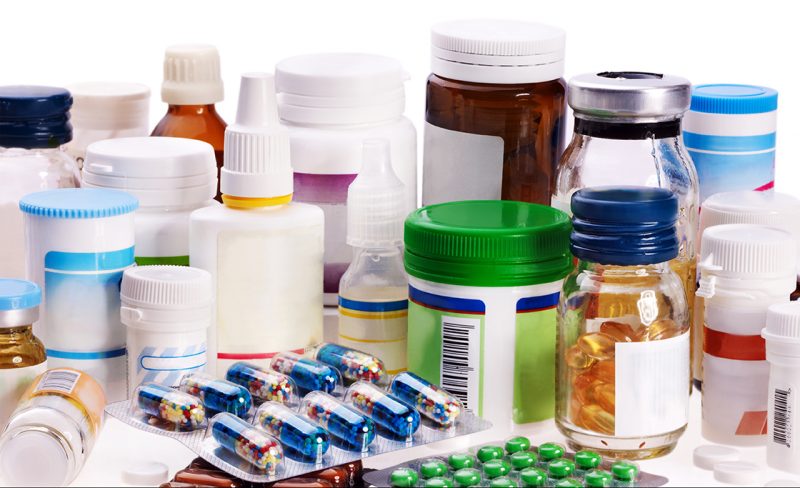
With local use of the ointment, interaction with other external agents has not been identified. Alpizarin tablets can be taken with vitamins, alcohol tinctures of Eleutherococcus and pantocrine, antibiotic, hormonal and anti-allergic pharmaceuticals.
Contraindications, side effects and overdose
Alpizarin is contraindicated in:
- with an allergy to any of the components of the medication;
- pregnant women (for tablets), 1 trimester of gestation - for ointment;
- ointment - for infants up to a year, tablets - for children under 3 years old;
- with a violation of the absorption of glucose and galactose, a deficiency of lactase, intolerance to milk sugar.
The maximum daily children's dose of the drug contains carbohydrates per 0.03 bread units, in a dose for patients from 12 years old - no more than 0.08 XE. Whereas in the Alpizarin tablet there is an amount of lactose and starch corresponding to an index of 0.01 bread units.
The medicine has a plant basis and is very well tolerated by patients. Undesirable reactions occur more often in people with drug and food allergies - in such patients, rashes on the body can occur, which disappear when the medicine is canceled.
With cutaneous application of the ointment, side effects are very rare, when mucous membranes are treated, mild burning sometimes occurs.
Lubrication of the nasal passages with the herpes virus form of rhinitis can cause sneezing and mucus for a short time.
An overdose of the drug to date has never been recorded, but if the recommended doses are exceeded, allergic manifestations are possible.
Analogs of the drug Alpizarin
There are no synonyms of the drug, that is, pharmaceuticals with the same active substance and therapeutic effect.
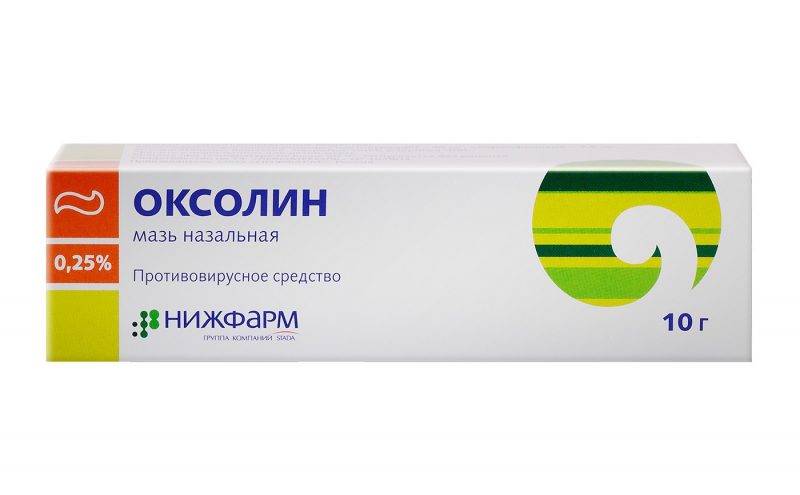
Alpizarin analogs or drugs with a similar therapeutic effect, but with a different composition: Valaciclovir, Likopid (tablets), Oxoline ointment, Vivorax, Zovirax (ointments), Panavir gel.


